Abstract
The corneal and blink reflexes were evaluated in 20 normal subjects and in 30 patients with motor deficits secondary to unilateral hemispheral lesions of vascular origin. In the normal population there were no differences between subjects below and subjects above 50 years of age. In the patients the reflex evoked by electrical stimulation of the cornea of the clinically affected side was depressed in 24 out of 30 cases. The depression mainly affected the afferent branch of the circuit, which triggers both homolateral and contralateral orbicularis oculi discharge (afferent abnormality). In three cases the depression was exerted concomitantly on the efferent branch (afferent and efferent abnormality) and only in one case was it limited to the efferent branch (efferent abnormality). The late R2 component of the blink reflex was depressed in 15 out of 30 patients. The early R1 component was slightly facilitated on the affected side. The changes of the corneal reflex and of the R2 component of blink reflex were similar, but the blink reflex had a greater safety factor. The patients with an abnormal corneal reflex had more extensive damage than had the patients with normal corneal response, as shown by computer tomography, but the site of the lesion was comparable in the two groups. Conduction through the brain stem circuits mediating the orbicularis oculi response is normally under pyramidal facilitatory influences while facial motoneurons are subjected to pyramidal inhibition. After pyramidal damage the transmission of impulses in the brain stem was slowed down, ultimately to a degree that abolished the reflex. Removal of pyramidal inhibition on facial motoneurons is probably the basis of the slight facilitation of the R1 component of the blink reflex.
Full text
PDF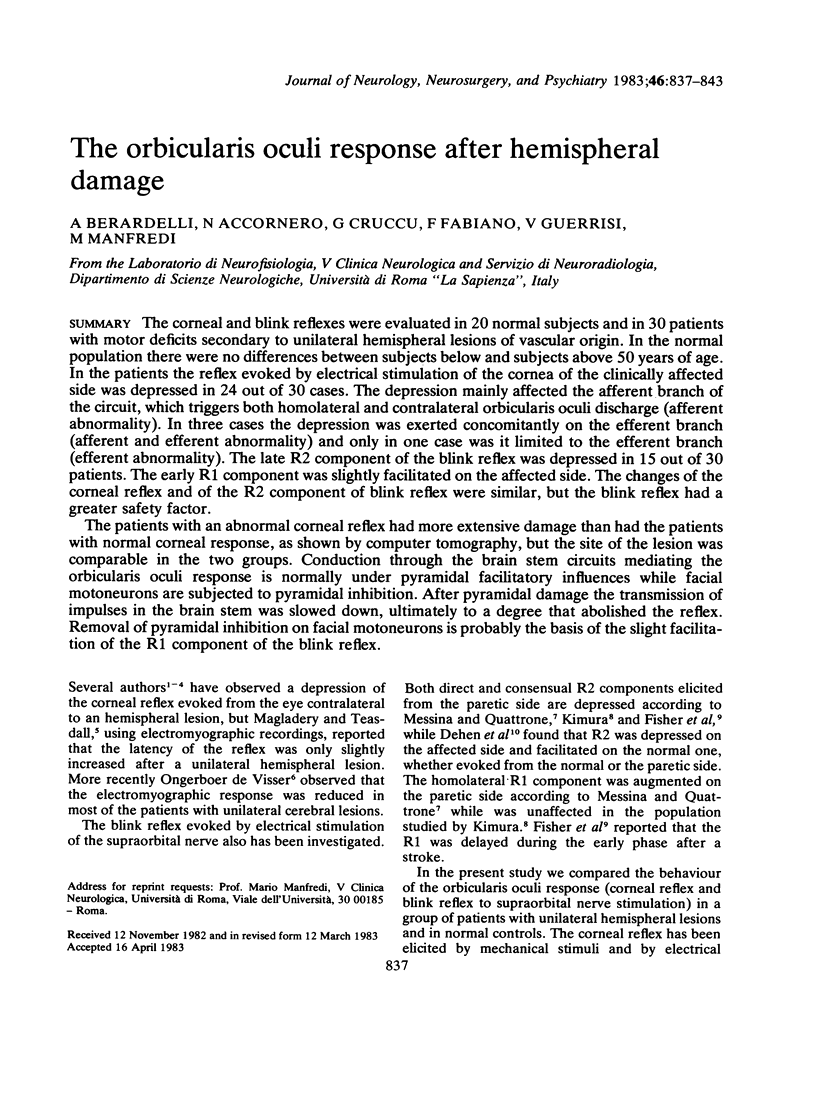
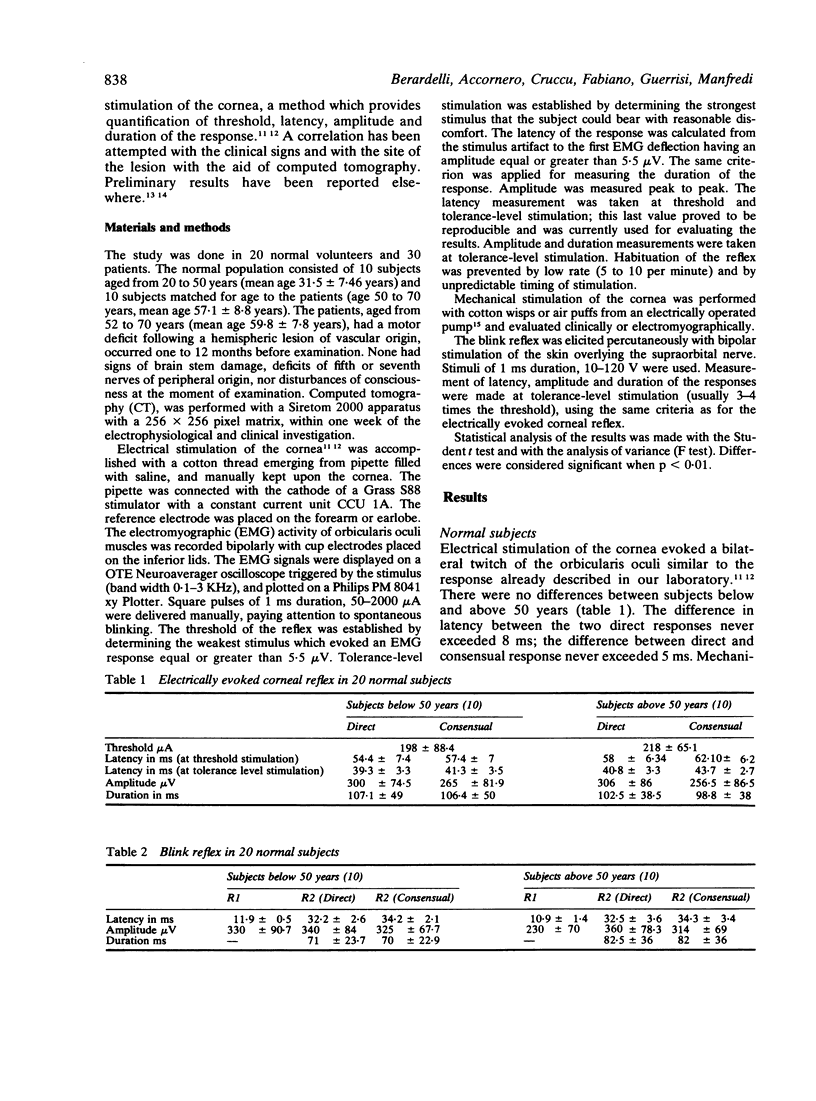
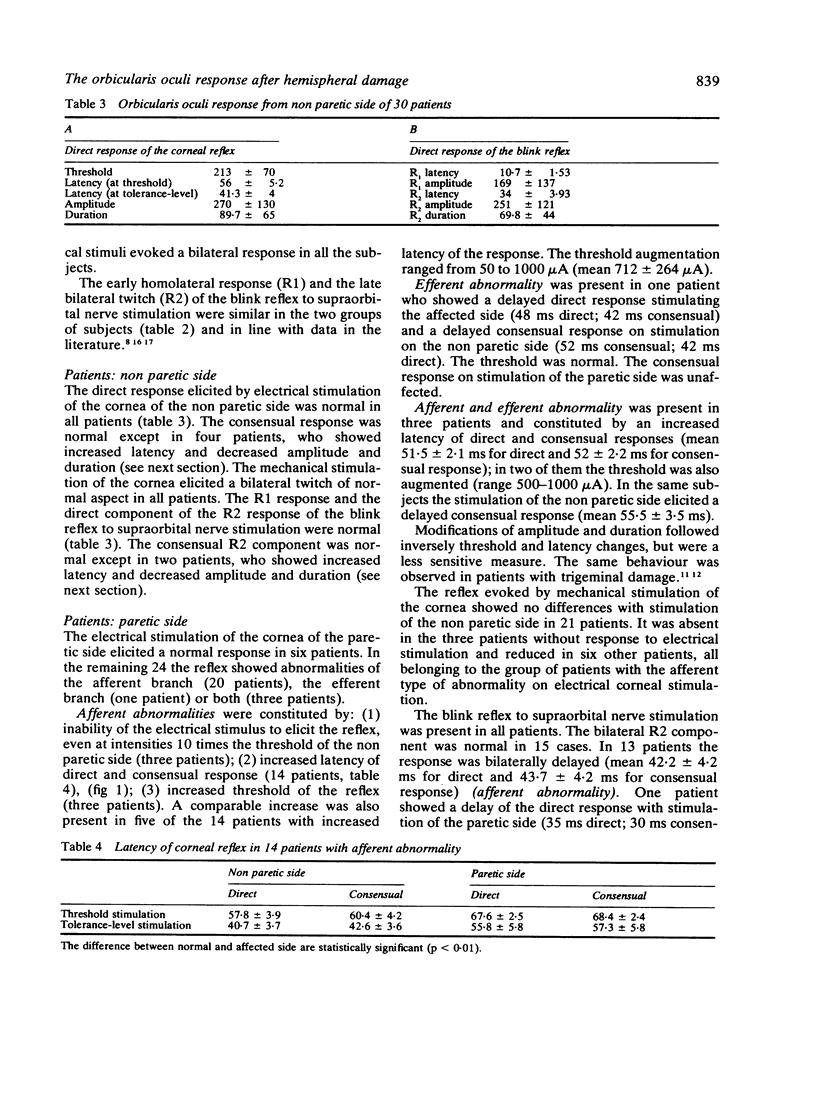
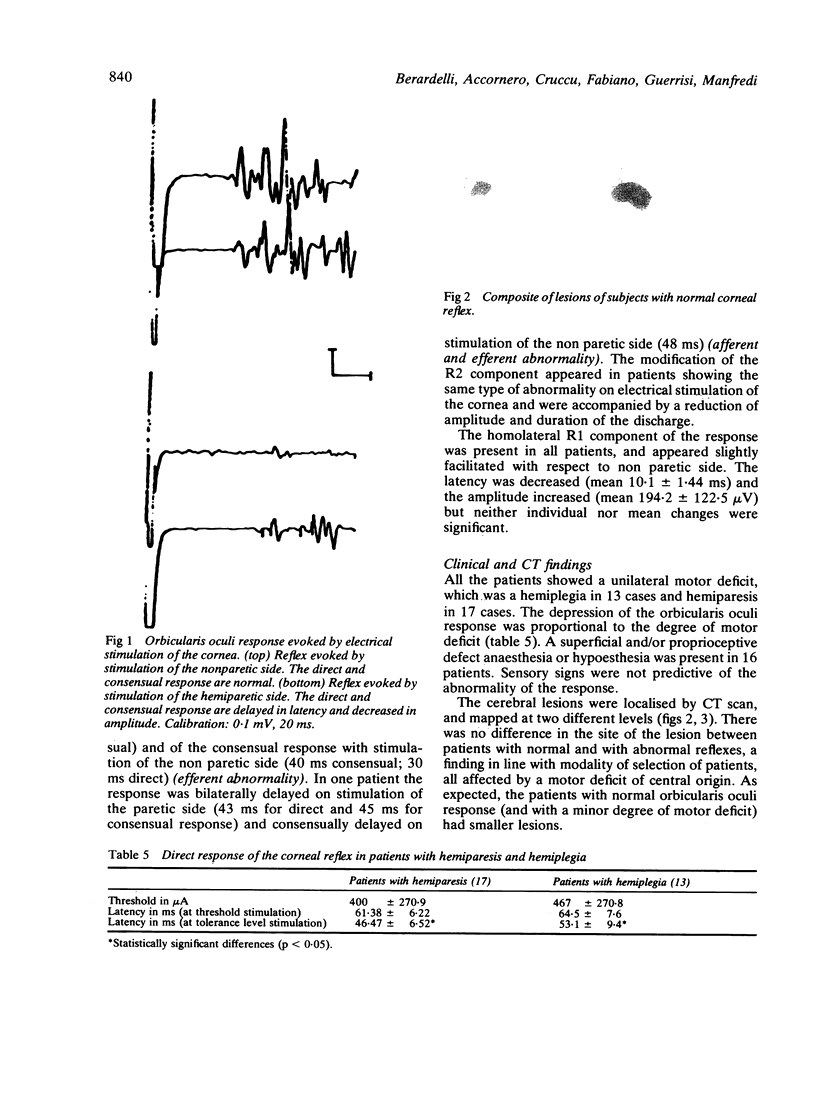
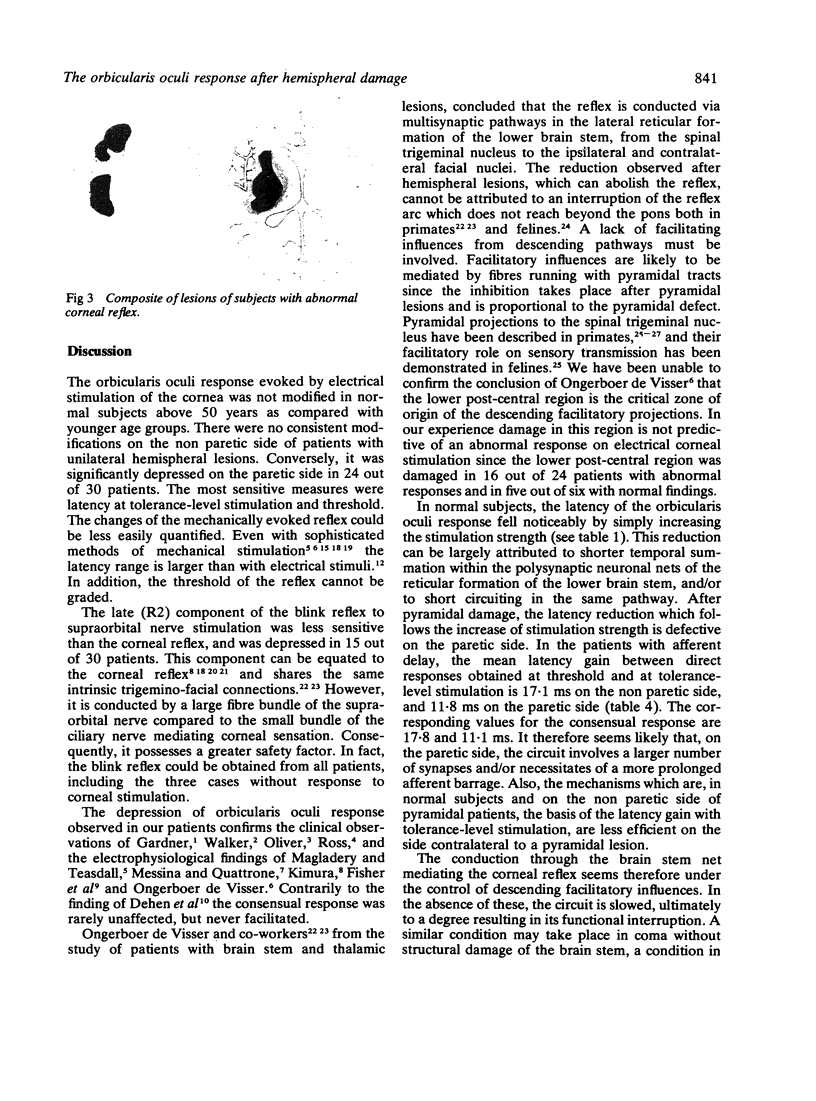


Images in this article
Selected References
These references are in PubMed. This may not be the complete list of references from this article.
- Accornero N., Berardelli A., Bini G., Cruccu G., Manfredi M., Caruso R., Noletti A. Metodo di registrazione del riflesso corneale nell'uomo mediante stimolazione fisiologica. Boll Soc Ital Biol Sper. 1978 Feb 15;54(3):249–251. [PubMed] [Google Scholar]
- Accornero N., Berardelli A., Bini G., Cruccu G., Manfredi M. Corneal reflex elicited by electrical stimulation of the human cornea. Neurology. 1980 Jul;30(7 Pt 1):782–785. doi: 10.1212/wnl.30.7.782. [DOI] [PubMed] [Google Scholar]
- Brodal P. The corticopontine projection in the rhesus monkey. Origin and principles of organization. Brain. 1978 Jun;101(2):251–283. doi: 10.1093/brain/101.2.251. [DOI] [PubMed] [Google Scholar]
- Dehen H., Willer J. C., Bathien N., Cambier J. Analyse électrophysiologique du réflexe de clignement (blink reflex) au cours de l'hémiplégie par lésions hémisphériques. Rev Neurol (Paris) 1975 Feb;131(2):85–94. [PubMed] [Google Scholar]
- Fisher M. A., Shahani B. T., Young R. R. Assessing segmental excitability after acute rostral lesions: II. The blink reflex. Neurology. 1979 Jan;29(1):45–50. doi: 10.1212/wnl.29.1.45. [DOI] [PubMed] [Google Scholar]
- Hiraoka M., Shimamura M. Neural mechanisms of the corneal blinking reflex in cats. Brain Res. 1977 Apr 15;125(2):265–275. doi: 10.1016/0006-8993(77)90620-5. [DOI] [PubMed] [Google Scholar]
- Jones E. G., Wise S. P. Size, laminar and columnar distribution of efferent cells in the sensory-motor cortex of monkeys. J Comp Neurol. 1977 Oct 15;175(4):391–438. doi: 10.1002/cne.901750403. [DOI] [PubMed] [Google Scholar]
- KUGELBERG E. [Facial reflexes]. Brain. 1952 Sep;75(3):385–396. doi: 10.1093/brain/75.3.385. [DOI] [PubMed] [Google Scholar]
- KUYPERS H. G. Central cortical projections to motor and somato-sensory cell groups. An experimental study in the rhesus monkey. Brain. 1960 Mar;83:161–184. doi: 10.1093/brain/83.1.161. [DOI] [PubMed] [Google Scholar]
- Kimura J. Effect of hemispheral lesions on the contralateral blink reflex. Neurology. 1974 Feb;24(2):168–174. doi: 10.1212/wnl.24.2.168. [DOI] [PubMed] [Google Scholar]
- Kimura J. Electrically elicited blink reflex in diagnosis of multiple sclerosis. Review of 260 patients over a seven-year period. Brain. 1975 Sep;98(3):413–426. doi: 10.1093/brain/98.3.413. [DOI] [PubMed] [Google Scholar]
- MAGLADERY J. W., TEASDALL R. D. Corneal reflexes. An electromygraphic study in man. Arch Neurol. 1961 Sep;5:269–274. doi: 10.1001/archneur.1961.00450150035004. [DOI] [PubMed] [Google Scholar]
- Messina C., Quattrone A. Comportamento dei riflessi trigemino-facciali in soggetti con lesioni emisferiche. Riv Neurol. 1973 Nov-Dec;43(6):379–386. [PubMed] [Google Scholar]
- OLIVER L. C. The supranuclear arc of the corneal reflex. Acta Psychiatr Neurol Scand. 1952;27(3-4):329–333. doi: 10.1111/j.1600-0447.1952.tb04665.x. [DOI] [PubMed] [Google Scholar]
- Ongerboer de Visser B. W. Corneal reflex latency in lesions of the lower postcentral region. Neurology. 1981 Jun;31(6):701–707. doi: 10.1212/wnl.31.6.701. [DOI] [PubMed] [Google Scholar]
- Ongerboer de Visser B. W., Kuypers H. G. Late blink reflex changes in lateral medullary lesions. An electrophysiological and neuro-anatomical study of Wallenberg's Syndrome. Brain. 1978 Jun;101(2):285–294. doi: 10.1093/brain/101.2.285. [DOI] [PubMed] [Google Scholar]
- Ongerboer de Visser B. W., Melchelse K., Megens P. H. Corneal reflex latency in trigeminal nerve lesions. Neurology. 1977 Dec;27(12):1164–1167. doi: 10.1212/wnl.27.12.1164. [DOI] [PubMed] [Google Scholar]
- Ongerboer de Visser B. W., Moffie D. Effects of brain-stem and thalamic lesions on the corneal reflex: an electrophysiological and anatomical study. Brain. 1979 Sep;102(3):595–608. doi: 10.1093/brain/102.3.595. [DOI] [PubMed] [Google Scholar]
- RUSHWORTH G. Observations on blink reflexes. J Neurol Neurosurg Psychiatry. 1962 May;25:93–108. doi: 10.1136/jnnp.25.2.93. [DOI] [PMC free article] [PubMed] [Google Scholar]
- Ross R. T. Corneal reflex in hemisphere disease. J Neurol Neurosurg Psychiatry. 1972 Dec;35(6):877–880. doi: 10.1136/jnnp.35.6.877. [DOI] [PMC free article] [PubMed] [Google Scholar]
- Shahani B. T., Young R. R. Human orbicularis oculi reflexes. Neurology. 1972 Feb;22(2):149–154. doi: 10.1212/wnl.22.2.149. [DOI] [PubMed] [Google Scholar]
- Thatcher D. B., Van Allen M. W. Corneal reflex latency. Neurology. 1971 Jul;21(7):735–737. doi: 10.1212/wnl.21.7.735. [DOI] [PubMed] [Google Scholar]
- Trontelj M. A., Trontelj J. V. Reflex arc of the first component of the human blink reflex: a single motoneurone study. J Neurol Neurosurg Psychiatry. 1978 Jun;41(6):538–547. doi: 10.1136/jnnp.41.6.538. [DOI] [PMC free article] [PubMed] [Google Scholar]




